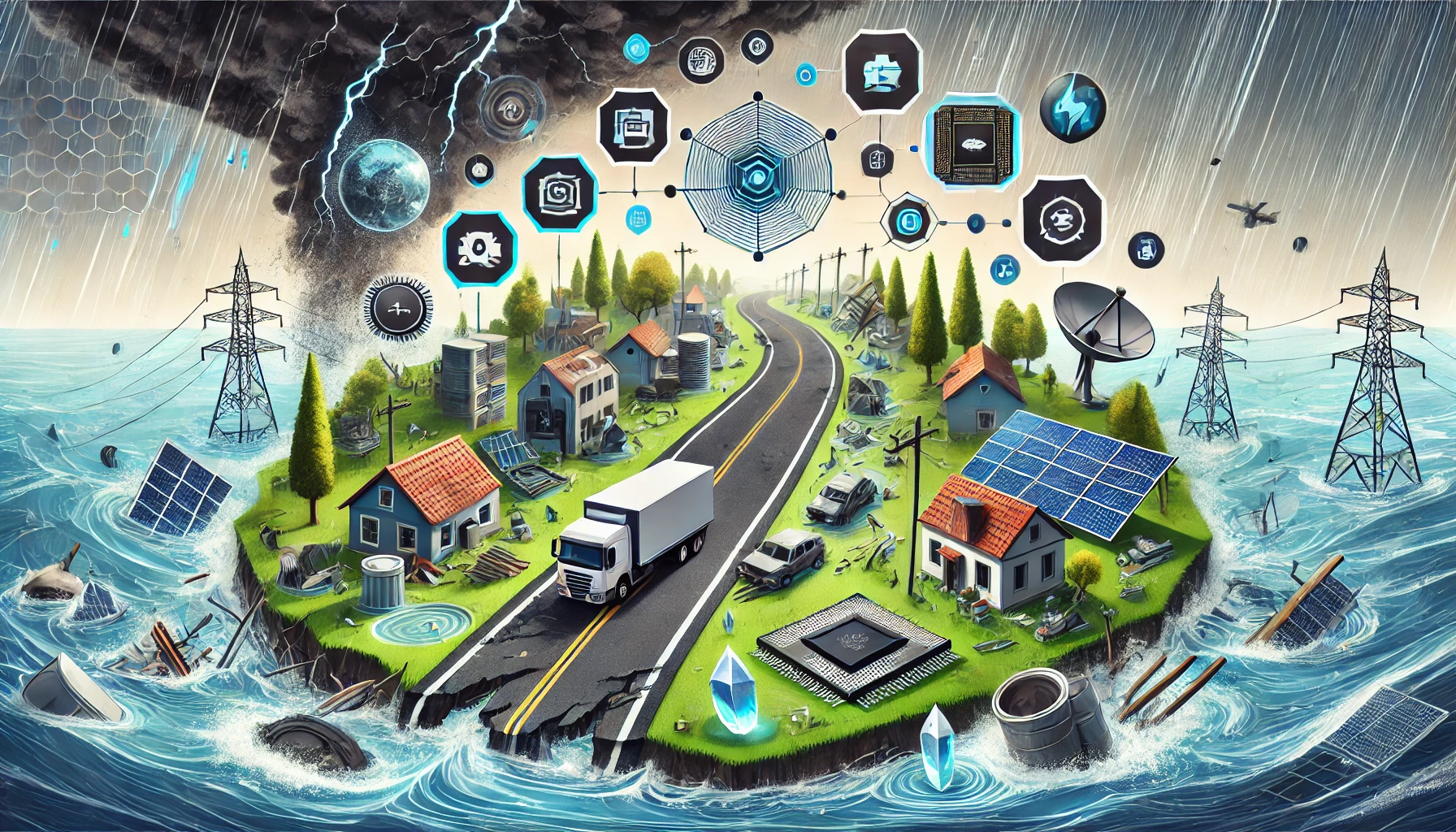How Hurricane Helene’s Devastation in North Carolina Threatens the Global Tech Industry
Hurricane Helene struck the small town of Spruce Pine, North Carolina, leaving behind a path of destruction and severe implications for the global tech industry. Spruce Pine, home to the world’s most crucial supply of high-purity quartz, plays a pivotal role in the production of semiconductors and solar panels. The floodwaters, fallen trees, and ruined infrastructure have raised concerns about potential disruptions in the tech industry’s supply chain. How did a town of fewer than 2,200 residents come to hold such global significance?
This blog explores the impact of Hurricane Helene in North Carolina, how hurricane damage has severely threatened the tech industry, and why the world’s reliance on this tiny Appalachian town’s quartz supply is a pressing concern for the semiconductor industry.
Spruce Pine: A Tiny Town with a Giant Role in the Tech World
Nestled in the Appalachian Mountains, Spruce Pine is known not just for its scenic beauty but for its rich deposits of high-purity quartz. This small town is responsible for producing the highest-quality quartz, an essential material in creating the silicon chip raw materials that fuel the global tech industry(opb).
Silicon chips, found in nearly every modern electronic device, depend on quartz to produce the wafers that are the foundation of semiconductors. Without the ultra-pure quartz from North Carolina quartz mines, manufacturers would struggle to meet the demand for semiconductors, leading to a semiconductor quartz shortage that could impact industries ranging from consumer electronics to renewable energy.
Hurricane Helene’s Damage to Tech and Quartz Supply
Hurricane Helene’s impact on tech is directly tied to its devastation in Spruce Pine. After dumping more than 2 feet of rain on the town, hurricane damage washed out key roads, destroyed local infrastructure, and cut off power. These effects have raised alarms about the potential consequences for the global tech supply chain(opb).
The town’s mines, which produce quartz for semiconductor and solar panel manufacturers, are now at risk. Flooded railroads and blocked roads hinder the transportation of quartz from the region, making it difficult to deliver the crucial raw material to manufacturers. This interruption could cause a massive tech industry supply chain disruption, delaying production and raising costs for electronics and solar technologies.
The High-Purity Quartz Supply Chain
Spruce Pine quartz supply isn’t just vital—it’s irreplaceable. Quartz of such purity is required to make crucibles that can withstand the extreme heat needed for semiconductor and solar panel manufacturing. While some efforts have been made to find alternative sources, no other location has been able to replicate the quality found in Spruce Pine.
Without access to this ultra-pure quartz, companies risk facing a semiconductor quartz shortage that could reverberate across global supply chains. Silicon chip raw materials, like the quartz from North Carolina, are essential for many tech products, and losing access to them could slow down production for months(opb).
Why Hurricane Damage in North Carolina Affects the Tech World
While most people might not connect a hurricane in North Carolina with the global tech industry, Hurricane Helene’s damage to tech highlights how interconnected our world has become. In this case, hurricane damage isn’t just a local problem; it’s a global issue. The tech industry, which already faces challenges due to a post-pandemic semiconductor shortage, could be significantly affected by any disruption to quartz production.
In the past, natural disasters, such as earthquakes and wildfires, have caused ripple effects across industries dependent on materials like semiconductors. In 2008, a fire at a quartz refinery in Spruce Pine caused a similar supply chain disruption, leading to delays in semiconductor production that affected industries globally(opb). Hurricane quartz mine disruption now poses the same risk.
Long-Term Impact on the Semiconductor Industry
As the world becomes more reliant on technology, from smartphones to electric vehicles, the demand for semiconductors will only increase. The semiconductor industry’s reliance on high-purity quartz semiconductors places enormous pressure on regions like Spruce Pine to maintain consistent production. A disruption in the quartz supply could exacerbate an already strained semiconductor market, leading to higher prices and extended wait times for consumers.
Solutions to Mitigate Disruption
While some tech companies maintain stockpiles of quartz, a prolonged disruption in North Carolina quartz mines could leave manufacturers scrambling to find alternatives. Unfortunately, finding a suitable replacement for Spruce Pine quartz supply has proven challenging. Companies have experimented with synthetic materials, but none match the quality and purity needed for high-performance semiconductors.
If the Hurricane quartz mine disruption continues for more than a few weeks, the semiconductor quartz shortage could affect everything from solar panel production to consumer electronics. The longer the disruption lasts, the more industries will feel the impact, underscoring how essential this small town is to the global tech industry.
Global Competition for Quartz and Silicon Materials
The race to secure materials like quartz has become a crucial aspect of global competition between tech powers like the U.S. and China. Both countries rely heavily on quartz for the production of semiconductors and solar panels, with China importing much of its high-quality quartz from Spruce Pine(opb). The global supply chain disruption caused by Hurricane Helene could further intensify this competition, especially as countries scramble to strengthen their renewable energy sectors.
As the world pushes toward green technology and sustainability, ensuring the continued availability of materials like high-purity quartz will be critical to both economic and environmental goals. The disruption in North Carolina could prompt governments and companies alike to prioritize securing raw materials essential for the tech industry.
The Future of High-Purity Quartz Supply
The aftermath of Hurricane Helene in North Carolina has opened up conversations about the vulnerability of the global supply chain, particularly for rare materials like quartz. It’s clear that securing alternative sources of high-purity quartz or finding ways to mitigate supply chain risks will become an essential focus for tech companies moving forward.
Whether through government intervention or private industry initiatives, ensuring the resilience of the quartz supply chain is now a priority for companies in the semiconductor and renewable energy sectors. Only time will tell how quickly North Carolina’s quartz mines can recover from the hurricane damage, and what steps will be taken to ensure that such a vital supply isn’t compromised in the future.
The devastation caused by Hurricane Helene in North Carolina has underscored how a seemingly isolated event can have far-reaching consequences for the global tech industry. Hurricane damage to the Spruce Pine quartz supply has not only impacted local residents but also threatens a semiconductor quartz shortage that could disrupt production for months. With tech companies and governments relying on North Carolina’s high-purity quartz for critical technologies, the stakes are high.
As industries work to recover from the hurricane’s impact on tech, the importance of securing a resilient supply chain for silicon and quartz materials becomes more evident. For more on supply chain resilience and global material dependencies, visit Regent Studies and learn how strategic planning can mitigate future disruptions.
For further reading on the tech industry’s reliance on raw materials, explore this report by NPR.



